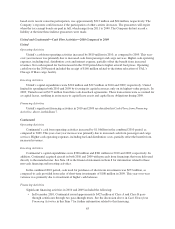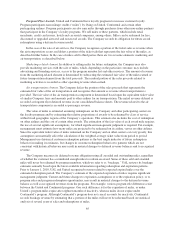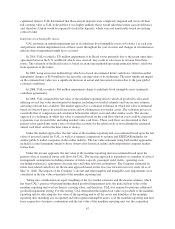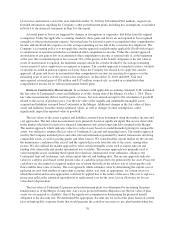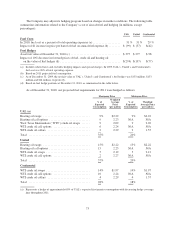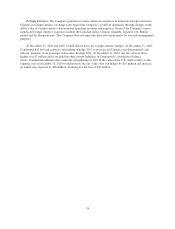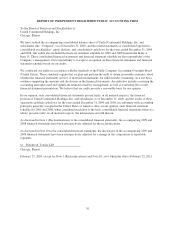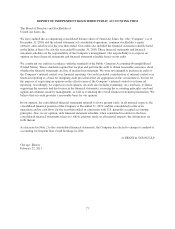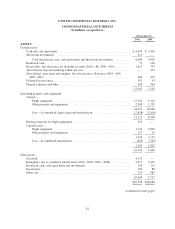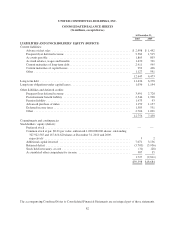United Airlines 2010 Annual Report Download - page 74
Download and view the complete annual report
Please find page 74 of the 2010 United Airlines annual report below. You can navigate through the pages in the report by either clicking on the pages listed below, or by using the keyword search tool below to find specific information within the annual report.
ITEM 7A. QUANTITATIVE AND QUALITATIVE DISCLOSURES ABOUT MARKET RISK
Interest Rates. Our net income (loss) is affected by fluctuations in interest rates (e.g. interest expense on
variable-rate debt and interest income earned on short-term investments). The Company’s policy is to manage
interest rate risk through a combination of fixed and variable rate debt and by entering into swap agreements,
depending upon market conditions. The following table summarizes information related to the Company’s
interest rate market risk at December 31, 2010 (in millions):
UAL (a) United (a) Continental
Variable rate debt
Carrying value of variable-rate debt at December 31, 2010 (b) .............. $ 3,758 $2,400 $1,358
Impact of 100 basis point increase on projected 2011 interest expense (c) ..... 37 24 13
Fixed rate debt
Carrying value of fixed rate debt at December 31, 2010 (d) ................ 10,087 4,626 5,043
Fair value of fixed rate debt at December 31, 2010 (e) .................... 11,292 5,026 5,284
Impact of 100 basis point increase in market rates on fair value (f) .......... 369 159 206
(a) UAL and United presented interest rate market risk disclosures in a tabular format in 2009. Management believes that the
sensitivity analysis presentation provides a better disclosure by quantifying the potential impact of an assumed interest
rate change. Due to this change, UAL and United are also disclosing sensitivity analysis for their debt outstanding at
December 31, 2009.
(b) As of December 31, 2009, UAL, United and Continental had outstanding variable rate debt of $2.6 billion, $2.6 billion
and $2.0 billion, respectively.
(c) Based on UAL’s and United’s variable rate debt at December 31, 2009, the impact of an assumed 100 basis point change
for UAL and United on 2010 interest expense would have been $26 million.
(d) As of December 31, 2009, UAL, United and Continental had outstanding fixed rate debt with a carrying value of $4.7
billion, $4.3 billion and $4.1 billion, respectively.
(e) As of December 31, 2009, UAL, United and Continental had fixed rate debt with a fair value of $4.1 billion, $3.5 billion
and $4.0 billion, respectively.
(f) If market interest rates increased 100 basis points at December 31, 2009, the fair value of UAL and United fixed-rate
debt outstanding at December 31, 2009, would have decreased by approximately $83 million and $80 million,
respectively.
A change in market interest rates would also impact interest income earned on our cash, cash equivalents
and short-term investments. Assuming our cash, cash equivalents and short-term investments remain at their
average 2010 levels, a 100 basis point increase or decrease in interest rates would result in a corresponding
increase or decrease in UAL, United and Continental interest income of approximately $77 million, $43 million
and $34 million, respectively, during 2011.
Commodity Price Risk (Aircraft Fuel). Our results of operations and liquidity are significantly impacted by
changes in the price of aircraft fuel.
To protect against increases in the prices of aircraft fuel, the Company routinely hedges a portion of its
future fuel requirements, provided the hedges are expected to be cost effective. The Company uses fixed price
swaps, purchased call options, collars or other such commonly used financial hedge instruments. These hedge
instruments are based directly on aircraft fuel or closely related commodities like heating oil and crude oil. The
Company strives to maintain fuel hedging levels and exposure consistent with industry standards so that the
Company’s fuel cost is not disproportionate to the fuel costs of its major competitors.
Some hedge instruments may result in losses if the underlying commodity prices drop below specified
floors or swap prices. However, the negative impact of these losses may be outweighed by the benefit of lower
aircraft fuel cost since the Company typically hedges a portion of its future fuel requirements, and uses swaps or
sold puts (as a part of a collar) on only a portion of the fuel requirement that it does hedge. The Company does
not enter into derivative instruments for non-risk management purposes.
72



